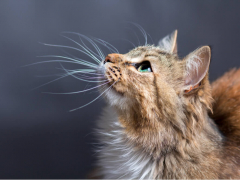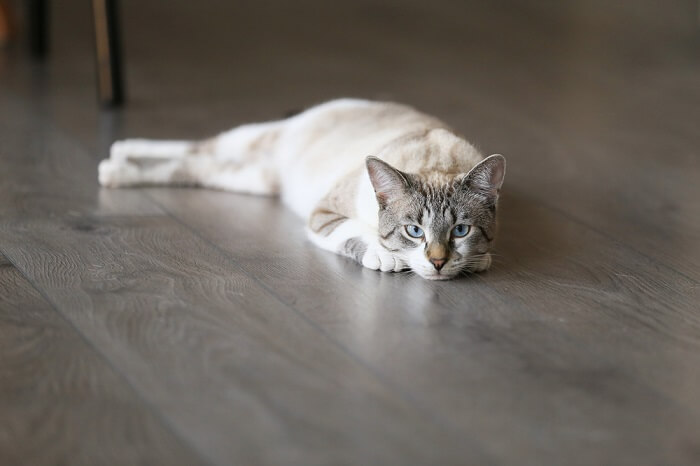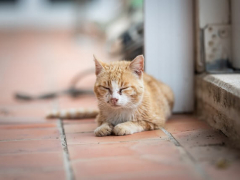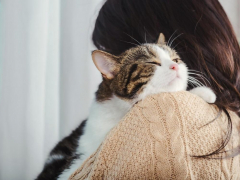
Pink eye is another word for conjunctivitis, or inflammation of the thin, moist tissue that lines the eyes and inner eyelids.
Many different things can cause pink eye in cats, but infections are the most common culprit. Treatment and prognosis depend on what’s causing the pink eye, and veterinary care is recommended regardless of cause to protect the eye from damage.
Here, we’ll discuss what to look for, possible causes, diagnostic tests, and common treatments.
What Is Pink Eye in Cats?
“Pink eye” does not refer to just one condition. It’s a symptom rather than a diagnosis, and it describes the redness, irritation, and swelling that occur around the eyes with conjunctivitis.
So, what is conjunctivitis?
The “conjunctiva” is a thin, clear to pink tissue lining that covers the eyes and the inner surfaces of the eyelids. It produces mucus, which helps the eyelids glide over the eyes without friction.
Conjunctivitis means inflammation of this conjunctiva, which may happen in just one eye or both eyes at once due to a variety of causes. This inflammation can cause pain or discomfort in the eye area, as well as symptoms like redness, swelling, and eye discharge.
Pink eye or conjunctivitis is the most common eye condition in cats, so many cats will have this condition at least once in their lifetime.
Symptoms of Pink Eye
When the conjunctiva is inflamed, the eyelids look red, puffy, or even swollen.
This may be accompanied by excessive tearing (epiphora), goopy or mucoid discharge from the eye, squinting, elevation of the third eyelid (a membrane located at the inner corner of each eye), or sensitivity to light.
Some or all of these symptoms may occur in one or both eyes. And these symptoms aren’t limited to conjunctivitis—they can also occur with other eye problems such as a corneal ulcer (a scratch or abrasion on the surface of the eye).
No matter what the cause, it’s important to seek veterinary care so the eye problem doesn’t get worse.
If an infection is what led to pink eye, it’s possible other symptoms may be noted, such as a fever, loss of appetite, wheezing, sneezing, nasal discharge, or mouth ulcers and drooling.
Causes of Pink Eye

Infections like calicivirus, herpesvirus, and others, are the most common cause of pink eye or conjunctivitis.
In cats, infections are the most common cause of conjunctivitis.
Here are some infections that can lead to pink eye in cats:
- Feline viral rhinotracheitis (FVR), also know as feline herpesvirus – This upper respiratory infection can also cause eye ulcers. It’s very common in cats—most felines are exposed during kittenhood, and many cats carry the virus their entire lives in a dormant state with no symptoms. Then, if the cat experiences stress (for example, due to a change at home or becoming ill), the virus flares up and causes symptoms.
- Other viruses, such as feline calicivirus.
- Bacterial infections such as Chlamydophila felis or Mycoplasma may cause conjunctivitis in cats.
- Secondary infections with bacteria may also occur secondary to any cause of conjunctivitis, making symptoms worse.
Pink eye or conjunctivitis may also occur due to non-infectious causes. Here are a few examples:
- Irritants, such as foreign material like dust or sand getting stuck under the eyelid, or chemical exposures.
- Seasonal or environmental allergies.
- Tumors or cancers of the eye.
- Chronic dry eye.
- A blocked tear duct.
Is Pink Eye in Cats Contagious?
Infectious pink eye is highly contagious between cats!
Affected cats should be isolated in a small room if possible, to avoid spreading the infection to other cats in the home.
Wear a smock or coverup while tending to your cat with conjunctivitis, then wash your hands before petting or feeding other cats in your home.
Fortunately, viruses tend to be species-specific—which means that you (and your dog) can’t catch feline herpesvirus. But certain types of bacteria may be picked up by other species, including humans.
While the spread of bacterial conjunctivitis from cats to humans is rare, it’s always best to be on the safe side and wash your hands after petting or medicating a cat with pink eye.
How Is Pink Eye Diagnosed in Cats?
Since pink eye is a symptom and not a specific disease, a veterinarian can declare that a cat has pink eye just by doing a physical exam.
However, it’s important to determine what’s causing the pink eye, and to rule out concurrent issues such as an eye ulcer that could cause permanent scarring of the cornea (surface of the central eye area) or even blindness or loss of an eye if severe.
In addition to a physical examination, a vet may perform tests for tear production and intraocular pressure (pressure inside the eye), and use a special stain to look for ulcers or abnormalities on the surface of the eyes.
If further evaluation is indicated, especially if the eye condition is severe or recurs frequently, additional diagnostics such as bloodwork, biopsies, or infectious disease testing may be the next step.
Pink Eye Treatment
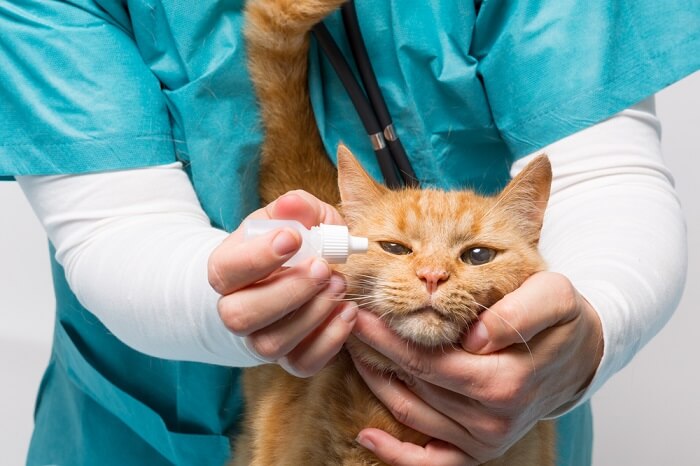
Eye problems can get worse quickly, so follow your vet’s instructions exactly—and don’t skip the recheck appointment!
Treatment varies depending on your cat’s needs, but common treatments for pink eye include:
- Antibiotics in the form of eye drops or ointments, and/or oral medications. Even with viral infections, antibiotics may be prescribed to prevent complications from secondary bacterial infections.
- Anti-inflammatories or pain medications prescribed as eye drops/ointments, and/or oral medications.
- Antiviral medications if indicated (usually this is reserved for more severe infections).
- An Elizabethan collar to prevent scratching of the eye that could otherwise lead to an eye injury.
- L-lysine supplement to help with immune system function against viral infections. If a cat has recurrent infections with feline herpesvirus, a vet may recommend this supplement for lifelong use.
- Isolating a cat with conjunctivitis from other cats in the home, to prevent spread of the infection.
- Referral to a specialist (veterinary ophthalmologist) for severe, complicated, or non-improving conditions.
Tip: If you’re not sure how to give your cat eye ointments or drops, ask your vet team for a demonstration.
A word of caution: Giving the wrong eye medication can make eye problems worse. So never give over the counter medications or previously prescribed eye medications without first checking with your vet.
Remember pink eye or conjunctivitis is a very common condition in cats that involves inflammation, redness, and irritation of the tissues around the eyes and inner surface of the eyelids. Infections are the most common cause, but many different causes are possible.
Fortunately, most cases of pink eye clear up quickly with medications. But it’s important to seek veterinary care as soon as possible and follow up as recommended, to prevent the condition from getting worse or resulting in eye damage.
Frequently Asked Questions
How do you treat pink eye in cats?
Treatment depends on the underlying cause, but commonly includes medications (eye drops/ointments, with or without oral medications) to treat infections or relieve inflammation and pain. Close monitoring is necessary to ensure healing is taking place.
How long does pink eye last in cats?
Usually, significant improvement is noted in the first few days. But treatment may be needed for up to three weeks. It’s important to give the full course of all medications—even if your cat’s eye is looking better—to prevent reoccurrence.
Can you get pink eye from cats?
Fortunately, most infectious causes of pink eye in cats are not transmissible to humans. However, in rare cases humans may pick up bacterial conjunctivitis from a cat, so it’s a good practice to wash your hands after petting or medicating a cat with pink eye.
How do you know if your cat has pink eye?
If your cat has pink eye, their eyelid(s) may look red, inflamed, puffy, or swollen. You might also notice squinting, tearing, goopy eye discharge, or other symptoms.
These symptoms may also occur with other eye problems such as eye ulcers or injuries. So if you notice eye symptoms, a veterinary visit is needed.
